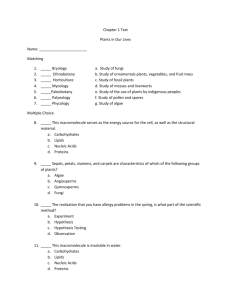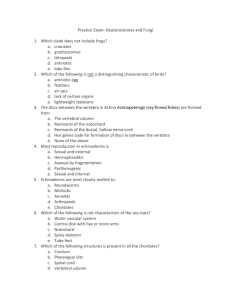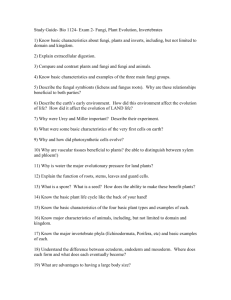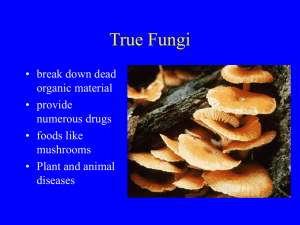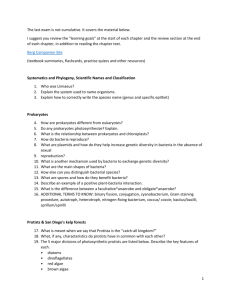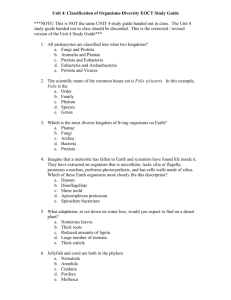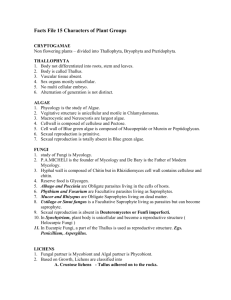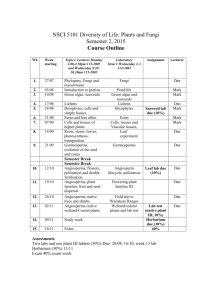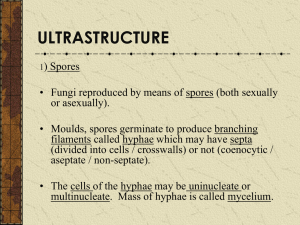Practice Exam 2 Below are sample questions from your book (all the
advertisement
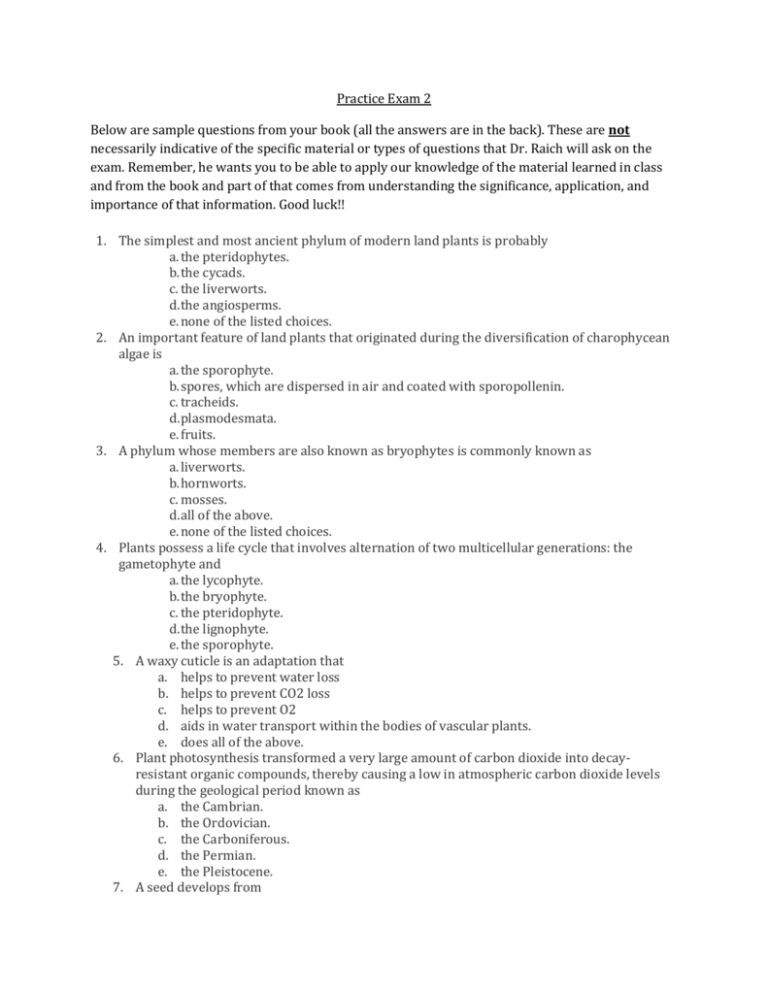
Practice Exam 2 Below are sample questions from your book (all the answers are in the back). These are not necessarily indicative of the specific material or types of questions that Dr. Raich will ask on the exam. Remember, he wants you to be able to apply our knowledge of the material learned in class and from the book and part of that comes from understanding the significance, application, and importance of that information. Good luck!! 1. The simplest and most ancient phylum of modern land plants is probably a. the pteridophytes. b. the cycads. c. the liverworts. d. the angiosperms. e. none of the listed choices. 2. An important feature of land plants that originated during the diversification of charophycean algae is a. the sporophyte. b. spores, which are dispersed in air and coated with sporopollenin. c. tracheids. d. plasmodesmata. e. fruits. 3. A phylum whose members are also known as bryophytes is commonly known as a. liverworts. b. hornworts. c. mosses. d. all of the above. e. none of the listed choices. 4. Plants possess a life cycle that involves alternation of two multicellular generations: the gametophyte and a. the lycophyte. b. the bryophyte. c. the pteridophyte. d. the lignophyte. e. the sporophyte. 5. A waxy cuticle is an adaptation that a. helps to prevent water loss b. helps to prevent CO2 loss c. helps to prevent O2 d. aids in water transport within the bodies of vascular plants. e. does all of the above. 6. Plant photosynthesis transformed a very large amount of carbon dioxide into decayresistant organic compounds, thereby causing a low in atmospheric carbon dioxide levels during the geological period known as a. the Cambrian. b. the Ordovician. c. the Carboniferous. d. the Permian. e. the Pleistocene. 7. A seed develops from a. b. c. d. e. a spore. a fertilized ovule. a microsporangium covered by integuments. endosperm. none of the above. 8. How long have gymnosperms been important members of plant communities? a. 10,000 years, since the dawn of agriculture b. 100,000 years c. 300,000 years d. 65 million years, since the K/T event e. 300 million years, since the Coal Age 9. What similar features do gymnosperms and angiosperms possess that differ from other modern vascular plants? a. Gymnosperms and angiosperms both produce flagellate sperm. b. Gymnosperms and angiosperms both produce flowers. c. Gymnosperms and angiosperms both produce tracheids, but not vessels, in their vascular tissues. d. Gymnosperms and angiosperms both produce fruits. e. none of the above 10. Which part of a flower receives pollen from the wind or a pollinating animal? a. perianth b. stigma c. filament d. pedicel e. ovary 11. The primary function of a fruit is to a. provide food for the developing seed. b. provide food for the developing seedling. c. foster pollen dispersal. d. foster seed dispersal. e. None of the above is the primary function. 12. What are some ways in which flowers have diversified? a. color b. number of flower parts c. fusion of organs d. aggregation into inflorescences e. all of the above 13. Flowers of the genus Fuchsia produce deep pink to red flowers that dangle from plants, produce nectar in floral tubes, and have no scent. Based on these features, which animal is most likely to be a coevolved pollinator? a. bee b. bat c. hummingbird d. butterfly e. moth 14. Which type of plant secondary metabolite is best known for the antioxidant properties of human foods such as blueberries, tea, and grape juice? a. alkaloids b. cannabinoids 15. 16. 17. 18. 19. 20. 21. 22. c. carotenoids d. phenolics e. terpenoids What features of domesticated grain crops might differ from those of wild ancestors? a. the degree to which ears shatter, allowing for seed dispersal b. grain size c. number of grains per ear d. softness and edibility of grains e. all of the above Conidia are a. cells produced by some fungi as the result of sexual reproduction. b. fungal asexual reproductive cells produced by the process of mitosis. c. structures that occur in septal pores. d. the unspecialized gametes of fungi. e. none of the above. What are mycorrhizae? a. the bodies of fungi, composed of hyphae b. fungi that attack plant roots, causing disease c. fungal hyphae that are massed together into stringlike structures d. fungi that have symbiotic partnerships with algae or cyanobacteria e. mutually beneficial associations of particular fungi and plant roots Where could you find diploid nuclei in an ascomycete or basidiomycete fungus? a. in spores b. in cells at the surfaces of fruiting bodies c. in conidia d. in soredia e. all of the above Which fungi are examples of hallucinogen producers? a. Claviceps and Psilocybe b. Epidermophyton and Candida c. Pneumocystis carinii and Histoplasma capsulatum d. Saccharomyces cerevisiae and Phanerochaete chrysosporium e. Cryphoenectria parasitica and Ventura inaequalis What forms do lichens take? a. crusts, flat bodies b. foliose, leaf-shaped bodies c. fruticose, erect or dangling bodies d. single cells e. a, b, and c Lichens consist of a partnership between fungi and what other organisms? a. red algae and brown algae b. green algae, cyanobacteria, and heterotrophic bacteria c. the roots of vascular plants d. choanoflagellates and Nuclearia e. none of the above How can ascomycetes be distinguished from basidiomycetes? a. Ascomycete hyphae have simple pores in their septa and lack clamp connections, whereas basidiomycete hyphae display complex septal pores and clamp connections. b. Ascomycetes produce sexual spores in sacs, whereas basidiomycetes produce sexual spores on the surfaces of club-shaped structures. c. Ascomycetes are commonly found in lichens, whereas basidiomycetes are less commonly partners in lichen associations. d. Ascomycetes are not commonly mycorrhizal partners, but basidiomycetes are commonly present in mycorrhizal associations. e. All of the above are correct. 23. Which group of organisms listed is most closely related to the kingdom Fungi? a. the animal kingdom b. the green algae c. the land plants d. the bacteria e. the archaea 24. What is an example of meiosis? a. 1n1n b. 2n1n c. 2n2n d. 3n e. A and C 25. What is an example of mitosis? a. 1n1n b. 2n1n c. 2n2n d. 3n e. A and C
